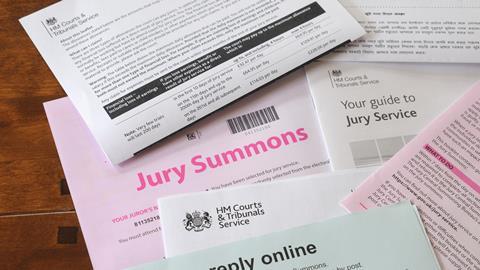Now and again, the weirdness of the pandemic hits you. After months of accepting ever tighter lockdown restrictions and throwing yourself into hedges as people approach on the footpath, you suddenly notice how peculiar life has become.
For me, realisation dawns as I sit in in a little Perspex cubicle in a large linoleumed room, not dissimilar to a school dining hall. I am surrounded by 60 or so masked figures, features warped by the walls of their own plastic boxes and the film of mist that has formed on the inside of my glasses. A woman in bright purple latex gloves and a surgical mask is scrubbing a chair with anti-bac.
Welcome to jury service 2021.
Since receiving my summons in December, I have oscillated between dread and curiosity. Are Crown courts really as ‘Covid-secure’ as HMCTS claims? Can I cope with meeting 11 new people after months of isolation? Will jurors be dropping like flies in a Covid-themed And Then There Were None?
Two weeks of court life revealed that HMCTS is doing its best in a difficult situation. On arrival at court, jurors are assailed by plexiglass, NHS posters, social-distancing stickers and hand sanitiser. Water fountains are cordoned off and buying food in the building is off-limits. Even the toilets have a one-in-one-out system, and the canteen has been converted into a (very efficient) lateral flow testing centre.
After some introductory talks in the Perspex-filled waiting area, the jury roll calls begin. If you are selected to serve on a case – some people never are – you are ferried into a deliberation room. Because of coronavirus, large courtrooms have been converted into deliberation rooms and jurors are allocated a specific seat for the duration of their service. There is also an elaborate numbering system, meaning jurors travel around the building in strict formation like some kind of dance troupe.
After various delays – more of which later – you enter the courtroom proper. For obvious reasons I'm not going to discuss the hearing itself, but my abiding memory of the jury box is the temperature. Jurors blithely walking in in T-shirts and flimsy blouses were greeted by HMCTS’s rambunctious ventilation system, which would be more suited to an indoor ski centre. Ten minutes in and you were thankful for your face mask, which provided a welcome barrier between the micro-climate.
The jury box itself is split into two to help with social distancing, and plastic screens shield you from your fellow jurors. We are also given a personal hand sanitiser - with a label saying ‘don’t drink’ – and latex gloves. The judge and counsel wear masks unless they are speaking.
Ultimately, while the measures may not have been perfect, they were carefully thought through and HMCTS staff strived to make us feel as safe as possible.
What did feel unacceptable, however, was the sheer number of delays unrelated to the pandemic. Days in court were repeatedly cut short – or never even started – throwing the inefficiency of the criminal justice system into sharp relief.
With the Crown court backlog at over 56,000 cases, and with jurors risking their health for the sake of civic duty, serious efforts are needed to make trials more efficient. Perspex and posters can only go so far.






























No comments yet